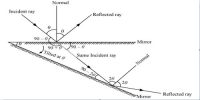Bartholinus discovered that when a ray of unpolarised light is incident on a calcite crystal, two refracted rays are produced. This phenomenon is called double refraction (Fig: a). Hence, two images of a single object are formed. This phenomenon is exhibited by several other crystals like quartz, mica etc.

Fig: Double refraction
When an ink dot on a sheet of paper is viewed through a calcite crystal, two images will be seen (Fig: b). On rotating the crystal, one image remains stationary, while the other rotates around the first. The stationary image is known as the ordinary image (O), produced by the refracted rays which obey the laws of refraction. These rays are known as ordinary rays. The other image is extraordinary image (E), produced by the refracted rays which do not obey the laws of refraction. These rays are known as extraordinary rays.
Inside a double refracting crystal the ordinary ray travels with same velocity in all directions and the extra ordinary ray travels with different velocities along different directions.
A point source inside a refracting crystal produces spherical wavefront corresponding to ordinary ray and elliptical wavefront corresponding to extraordinary ray.
Inside the crystal, there is a particular direction in which both the rays travel with same velocity. This direction is called the optic axis. The refractive index is the same for both rays and there is no double refraction along this direction.













